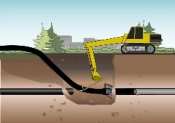 Sliplining
Sliplining
Oxford
Plastics manufactures heavy duty plastic pipe for trenchless methods
like sliplining or insertion renewal. Sliplining is
a popular and trusted trenchless method that allows you to rehabilitate
deteriorating pipe by inserting a smaller pipe into an existing
pipe. As a trenchless method, sliplining can be applied to either
pressure or gravity pipelines. Water, sanitary and storm sewers
can be renewed with minimum excavation. When done properly, sliplining
ensures that the rehabilitated pipe and lateral connections are
leak-tight, corrosion resistant, and capable of even
greater flow rates.
The
Sliplining Process
In the sliplining process, a winch cable is inserted through the
existing line and then attached to the front of the new liner. The
new liner pipe is then pulled into the existing pipe, and the new
liner pipe reconnected to the system. If needed, the void between
the new and old pipes can be filled by grouting.
Benefits:
- Sliplining can be used on most types of pipe.
- It is rapid and causes little disturbance to other utilities.
- It works the best with few connections.
- It improves hydraulic performance because of an improved friction
coefficient
- It can be installed in live lines without bypass pumping.
Drawbacks:
- When
the new pipe is pulled into an existing pipe, there is a reduction
in the inside diameter which means a loss of cross-sectional capacity.
This limits the process to pipe sizes of 8 to 96 inches in diameter.
- Sliplining requires a long area of space for assembly.
- There is an added cost of jointing techniques when limited to
using short pipe lengths.
- Poorly applied grouting can lead to buckling.
- Many excavations are required if there are too many service
and branch reconnections involved.
- Sliplining does not work well in pipelines with a lot of elbows.
Contact
us today by email or our toll free number:
sales@oxfordplasticsinc.com
1.800.263.0502
Some
Helpful Links
Centre
For Advancement of Trenchless Technlogies (University of
Waterloo)
North American
Society for Trenchless Technology
Trenchless Information
Center
|

 Sliplining
Sliplining